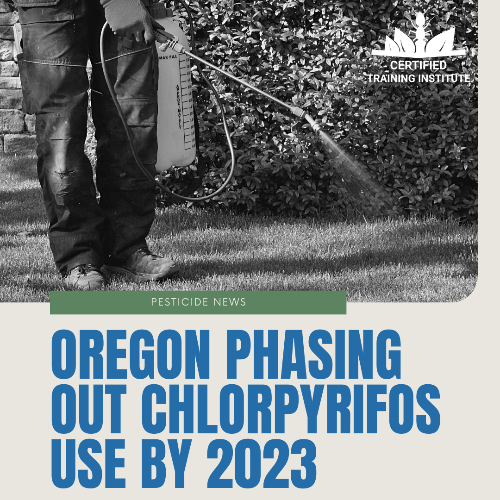Last week, the Oregon Department of Agriculture (ODA) filed Administrative Rules with the Oregon Secretary of State that immediately limits the use of chlorpyrifos-based products and phases out nearly all use by December 31, 2023.
ODA said they wrote the rules with the help of a “diverse workgroup” of leaders and experts from many backgrounds including agriculture, environmental justice groups, toxicologists, and farmworker health-and-safety organizations. ODA’s goal for these new rules is to reduce the risk potential exposure for “workers and bystanders.”
Chlorpyrifos, a popular “broad-spectrum” insecticide mainly used in Oregon on Christmas trees, leafy greens crops, and alfalfa, has been the subject of many critical studies over the years. To understand why Oregon is taking this action, we’ll first dive into the controversial history of chlorpyrifos.
Chlorpyrifos History & Toxicity Studies
Chlorpyrifos has been registered by the EPA as an insecticide since 1965, and is widely used on nearly 50 different crops including corn, soybeans, and almonds. It’s highly toxic to birds, fish, and bees. Chlorpyrifos is an organophosphate, which makes it a “nerve agent” – meaning it kills pests by creating an overstimulation in the nervous system. This effect also makes it highly toxic to birds, fish, and bees. In 2000, prolonged exposure to chlorpyrifos was deemed toxic enough to humans to get most residential uses banned outright.
Between 2000 and 2012, the EPA added additional restrictions on certain crops like tomatoes, and “curbed the insecticide’s use by reducing the rate at which it can be applied and banned its use in certain areas near residential and public spaces.”
Calls to ban all use of chlorpyrifos came from multiple studies linking chlorpyrifos to developmental issues in children. Here are summaries from just a few of the studies:
- “Low to moderate levels of exposure to the insecticide chlorpyrifos during pregnancy may lead to long-term, potentially irreversible changes in the brain structure of the child, according to a brain imaging study by researchers from the Columbia Center for Children’s Environmental Health at the Mailman School of Public Health, Duke University Medical Center, Emory University, and the New York State Psychiatric Institute. The changes in brain structure are consistent with cognitive deficits found in children exposed to this chemical.” – source
- “Exposure to the pesticide chlorpyrifos is associated with early childhood developmental delays, according to a study by researchers at Columbia University’s Mailman School of Public Health.” – source
- A UC Davis study found that mothers who live within a mile of fields where chlorpyrifos and other organophosphate pesticides were applied had a 60 percent higher chance of having children with autism spectrum disorder. – source
Studies like these along with pressure from many external forces led the EPA to propose the complete ban of chlorpyrifos in 2015, stating they were “unable to conclude that the risk from aggregate exposure from the use of chlorpyrifos meets the safety standard.” By as late as November 2016, the EPA was still on track to ban all chlorpyrifos use.
But in March 2017, the EPA (under a new administration and with new leadership), overturned these efforts and stated it won’t outright ban chlorpyrifos “without first attempting to come to a clearer scientific resolution” on the matter, a task it’s set to complete by 2022. A few studies (one from China and another from Canada) that influenced the EPA’s 2017 decision did not find any association between organophosphates developmental issues in children. However, the authors of both studies admit limits to their findings, and the doctor who conducted the Chinese study warned “results should be interpreted with caution, and more studies of children living in China are warranted.
With a federal-level ban off the table for the time being, states are taking action. In recent years, California, New York, Hawaii, and Maryland have either banned or greatly limited chlorpyrifos use. Now, with the context established, we return to Oregon.
Oregon’s New Rules
According to ODA, the following measures are effective immediately upon rule adoption:
- Use of chlorpyrifos for mosquito vector control, golf course turfgrass, and certain types of enclosed structures is prohibited
- A 4-day restricted entry interval after use for all crops, including nursery and Christmas Trees.
- Aerial application is prohibited on all crops, except for a very narrow window of time on Christmas trees.
- All applicators must pass a pesticide certification exam and obtain a license.
- Respiratory protection requirements are increased.
- Recordkeeping is required, and must be maintained for at least three years.
- To protect bystanders and water quality, expanded buffers are required around sensitive sites and waterways.
Effective January 1, 2021
- All products containing chlorpyrifos will be restricted-use, except for cattle ear tags.
Effective March 1, 2021
- All mixer or loaders of chlorpyrifos must either be a certified and licensed pesticide applicator, or have successfully completed a special training conducted or approved by ODA.
After December 31, 2023
- It is prohibited to use or sell chlorpyrifos except for:
- Commercial pre-plant seed treatments
- Granular formulations
- Cattle ear-tags
The final rule prohibits aerial application on all crops, except Christmas trees, for a ten-week window between April 1 and June 15. This permitted window will be prohibited after December 31, 2023, providing a transition period for the nation’s largest Christmas tree industry.
“We feel like we came up with a rule that gives some flexibility to the agricultural community, and is protective of workers, bystanders and water quality,” said Rose Kachadoorian, ODA pesticides program manager. “We will work with the industries as best we can to help find alternatives.”
What do you think of this latest chlorpyrifos ruling? Do you think more states should follow Oregon? Let us know on social media!
